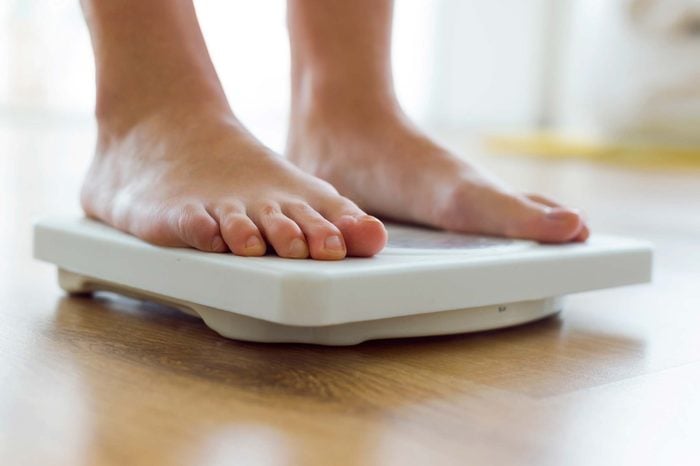
You feel like you have the flu, but you’re not getting better
Fever, chills, muscle aches and sleepiness are all classic signs of the common flu, or even Covid-19. But many people don’t realize they’re lupus symptoms as well, says Delphine Lee, MD, PhD, the former director of the Dirks/Dougherty Laboratory for Cancer Research and Department of Translational Immunology at John Wayne Cancer Institute at Providence Saint John’s Health Center in Santa Monica, CA. “The difference between the flu and lupus is that the flu gets better in four to 10 days,” she says, adding that the signs of lupus may last for weeks or months or come and go in cycles. With 1.5 million Americans struggling with lupus, it’s more common than you might think—and trickier to spot than most diseases. Here are other symptoms of lupus.

You’re losing weight but you’re not on a diet
Sudden, overnight weight may be one of the first signs of lupus. Because lupus is an autoimmune disorder, causing the body’s immune system to attack itself, it can throw your thyroid and hormones out of whack, which in turn affects your weight. Weight gain can also be one of the signs of lupus. Though Dr. Lee says weight loss is more common, lupus can also cause water retention, which may manifest as weight gain in some people.

You have tender bumps on your neck
Lymph nodes are small, bean-shaped structures throughout your body that help fight infection and filter out harmful substances. Normally you can’t see or feel them but when they’re working overtime, as in the case of lupus, they can become visibly swollen and painful to touch. The most common place to feel them is along your neck, down your jaw, and behind your ears, but they can also swell in your groin, abdomen, armpits, clavicle, and other places. “Swollen lymph nodes are occasionally seen as a result of a lupus flare,” says Joan T. Merrill, MD, the medical director of the Lupus Foundation of America and the head of the Clinical Pharmacology Research Program at the Oklahoma Medical Research Foundation Oklahoma City, OK. Those looking out for lupus symptoms will want to check in on their lymph nodes from time to time.

You get a rash in bright sunlight
A red, butterfly-shaped rash over your nose and cheeks that is triggered by sunlight is one of the more unique symptoms of lupus, Dr. Lee says. At first, it may look like you simply have a flushed face from the heat but unlike a heat rash, a lupus rash may linger long after you’ve left the sun.

“Exhausted” doesn’t even begin to describe how tired you feel
“This isn’t just your everyday tiredness; with lupus, you feel like you literally can’t get out of bed,” Dr. Lee says. Anemia or low numbers of red blood cells is another symptom of lupus that can cause extreme fatigue, according to the Lupus Foundation of America.
Of course, exhaustion can have many causes ranging from depression to mononucleosis. So this symptom on its own isn’t indicative of lupus, but if it’s one of a longer list of lupus symptoms, it’s worth considering.

You have blisters in weird places
A blister on your heel? Call a cobbler. A constellation of blisters inside your nose or mouth? Call a doctor. There are other illnesses that cause painful bumps on your body (such as sexually transmitted infections) but lesions on your mucous membranes are one of the common signs of lupus, Dr. Lee says.

Your hair is coming out in clumps
While lupus can affect either gender, 90% of all diagnoses are in women between the ages of 15 and 44. And one of the most telling symptoms of lupus is hair loss, Lee says. You may notice your hair thinning and losing significant volume over a short period of time.

Your hands are freezing, even in the summer
Is it just poor circulation, or is it something more? If your fingers or toes often get extremely cold, turn blue or feel numb, it could be Raynaud’s syndrome. This syndrome is an illness that affects circulation in the extremities and can be one of the signs of lupus, Dr. Lee says.

You feel like you’ve got arthritis but you’re only 30
Painful, swollen joints aren’t supposed to be a problem until you’re elderly, right? Not so fast, Dr. Lee says. Unfortunately, many young lupus patients experience arthritis-like symptoms in their joints, especially in their legs, with the pain often being the worst in the morning and getting better as the day goes on.

You have chest pain
“Heart attack!” is everyone’s first (panicked) thought when having chest pain. But if your doc clears you for heart disease, it may be a symptom of lupus. The autoimmune disease can cause swelling throughout the body, including in the sacs surrounding the heart and lungs, causing consistent, dull chest pain, Dr. Lee explains. If it’s your lungs that are primarily affected, you may also experience shortness of breath.
Chest pain can also be the sign of a lot of other very serious illnesses, though, so if you’re feeling discomfort in your chest, see a doctor immediately.
8 Causes of Exercise-Related Chest Pain Besides a Heart Attack

You’re having a psychotic break
“Lupus can attack any organ in the body and that includes the brain, sometimes causing psychosis,” Lee says. “Many people come in thinking they’ve suddenly got schizophrenia or are going crazy but in reality, it’s the disease.” Neurological symptoms of lupus can include hallucinations (both visual and auditory), paranoia, confusion, moodiness and seizures. If you are experiencing these things and have no prior history of mental illness, you may actually be experiencing one of the signs of lupus.

You’re legs are swollen
The kidneys are one of the most common organs to be affected by lupus. “Swelling in the legs can be seen when there is fluid retention due to kidney disease,” Dr. Merrill says.
Here’s How Much Protein You Really Need in a Day, with a Kidney Doctor’s Wisdom

You have multiple miscarriages
Lupus can cause problems with blood clotting, Lee says, and one of the saddest manifestations of this are repeated miscarriages. Getting pregnant may not be a problem, but staying pregnant can feel impossible. The clotting can also cause your periods to become heavy or irregular. It’s not the most common cause of infertility in women, but if you’re unable to have a baby and have some of these other symptoms, it’s worth getting tested for lupus.

You have lots of random, unexplained symptoms that don’t go away
Often called “the great masquerader,” lupus is a tricky disease as its symptoms mimic so many other illnesses. “Each person is different in how they’re affected because it depends entirely on which organ is being attacked by the immune system,” Dr. Lee explains. Worse, the disease often comes in “flares,” or periods of time where symptoms are particularly bad, interspersed with long periods where you feel fine, making you wonder if you’re just imagining things. This means that lupus is often a disease diagnosed only by the process of eliminating all other possible causes, Dr. Lee says—a process which can be extremely frustrating and disheartening for patients as they struggle to find answers. Thankfully there is a simple blood test that looks for anti-nuclear antibodies which can be a good indicator of lupus. Ultimately, however, you have to trust your body, Dr. Lee says. If you feel sick and you’re just not getting better, it’s important to get to the root cause, no matter what that is.
For more wellness updates, follow The Healthy on Facebook, Instagram, and Twitter. Keep reading:
- Hormonal vs. Nonhormonal IUD for Birth Control: Which Should You Get?
- Duchess Meghan Markle’s 11 Quiet Habits That Help Her “Survive and Thrive” in Royal Life
- Why Do We Wear Underwear? 8 Health Reasons You Need Them
- What Do Nutritionists Eat? We Peeked Inside a Dietitian’s Fridge and Found These Exact Groceries